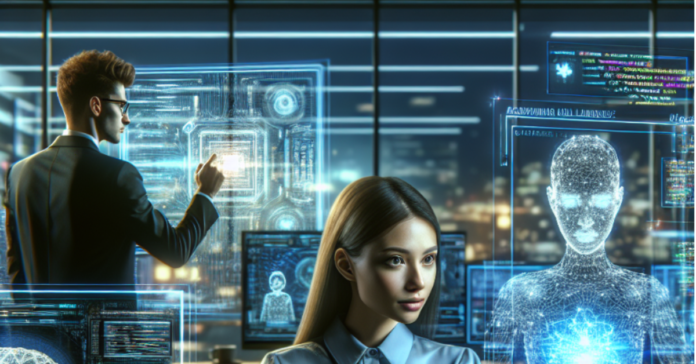Step into the thrilling realm where cutting-edge technology meets the frontline of digital defense! Picture this: a dynamic dance between artificial intelligence (AI) and cybersecurity, where each partner brings their A-game to the table. Dive deep with us as we unravel the fascinating bond between AI and cybersecurity, uncovering how they team up to conquer the challenges of our digitally-driven world.
Understanding AI
What Is AI?
Artificial Intelligence, commonly referred to as AI, is the field of computer science dedicated to creating systems that can perform tasks requiring human intelligence. These systems are designed to simulate human thought processes, enabling them to analyze data, recognize patterns, and make decisions autonomously.
Evolution of AI
The concept of AI dates back to the mid-20th century, with pioneers like Alan Turing envisioning machines capable of reasoning like humans. Over the decades, advancements in computing power and algorithms have propelled AI from theory to reality, revolutionizing various industries.
The Role of AI in Cybersecurity
AI in Cyber Defense
Cybersecurity organizations are increasingly turning to AI to bolster their defense mechanisms against evolving threats. AI-powered tools excel in tasks such as threat detection, anomaly identification, and predictive analysis. By analyzing vast datasets in real-time, AI can swiftly identify and neutralize potential threats, enhancing overall security posture.
Enhanced Threat Detection
One of the primary advantages of AI in cybersecurity is its ability to detect and respond to threats with unprecedented speed and accuracy. Unlike traditional methods, AI algorithms can sift through massive volumes of data, discerning subtle patterns indicative of malicious activity. This proactive approach enables cybersecurity professionals to stay ahead of emerging threats, mitigating risks more effectively.
Mitigating Human Error
Human error remains a significant vulnerability in cybersecurity. AI mitigates this risk by automating routine tasks and flagging potential security breaches in real-time. By reducing reliance on manual intervention, organizations can minimize the likelihood of costly errors and breaches, fortifying their defense posture.
Adaptive Security Measures
AI empowers cybersecurity systems to adapt and evolve in response to emerging threats. Machine learning algorithms can analyze attack patterns and adjust security protocols accordingly, effectively immunizing networks against known and unknown threats. This adaptive approach ensures robust protection against the dynamic threat landscape.
The Dark Side of AI: Exploitation by Cybercriminals

AI-Powered Attacks
While AI holds immense promise for cybersecurity, cybercriminals are also harnessing its capabilities for nefarious purposes. From sophisticated phishing scams to data manipulation techniques, hackers leverage AI to orchestrate more targeted and deceptive attacks.
Automated Social Engineering
AI enables cybercriminals to automate social engineering tactics, tailoring fraudulent messages to exploit psychological vulnerabilities. By analyzing vast troves of personal data, AI algorithms can craft highly convincing phishing emails and fraudulent communications, tricking unsuspecting individuals into divulging sensitive information.
Advanced Password Hacking
The advent of AI has turbocharged password-cracking techniques, enabling hackers to decipher complex passwords with unprecedented speed and accuracy. AI-powered algorithms can analyze patterns in user behavior and predict passwords with alarming precision, rendering traditional authentication measures increasingly vulnerable.
Deepfakes and Deception
Deepfake technology poses a significant threat to cybersecurity by allowing attackers to create convincing counterfeit audio and video content. By manipulating visual and auditory cues, cybercriminals can fabricate false narratives and impersonate trusted individuals, sowing confusion and misinformation on a massive scale.
Safeguarding Against AI-Driven Threats
Vigilance and Awareness
In light of AI’s dual role in cybersecurity, individuals and organizations must remain vigilant against emerging threats. Heightened awareness of AI-driven tactics, coupled with robust cybersecurity hygiene practices, is paramount to mitigating risks effectively.
Continuous Education
Staying abreast of the latest cybersecurity trends and threat vectors is crucial in the face of evolving AI-driven attacks. Continuous education and training programs empower individuals to proactively recognize and respond to emerging threats, bolstering overall cyber resilience.
Collaborative Defense Strategies
In an era defined by interconnectedness, collaboration is key to combating AI-driven cyber threats. By fostering information sharing and collaboration among industry stakeholders, organizations can collectively fortify their defenses and stay one step ahead of cyber adversaries.
Conclusion
The integration of AI into cybersecurity heralds a new era of innovation and challenges. While AI promises to revolutionize threat detection and mitigation, its proliferation also poses risks in the hands of malicious actors. By adopting a proactive and collaborative approach to cybersecurity, individuals and organizations can navigate this evolving landscape with confidence, safeguarding against emerging AI-driven threats.
FAQs
How does AI impact traditional cybersecurity practices?
AI augments traditional cybersecurity practices by automating threat detection, enhancing response times, and improving overall security efficacy.
What are some common AI-driven cyber threats?
Common AI-driven cyber threats include automated phishing attacks, advanced password cracking, deepfake manipulation, and data poisoning techniques.
How can individuals protect themselves against AI-driven threats?
Individuals can protect themselves by maintaining strong cybersecurity hygiene, being cautious of unsolicited communications, and staying informed about emerging threats.
What role does collaboration play in combating AI-driven threats?
Collaboration among industry stakeholders fosters collective intelligence-sharing and proactive defense strategies, enabling more robust protection against AI-driven threats.
How is the regulatory landscape evolving to address AI-driven cybersecurity risks?
Regulators are increasingly recognizing the need for comprehensive AI governance frameworks to mitigate cybersecurity risks and protect consumer data privacy.


